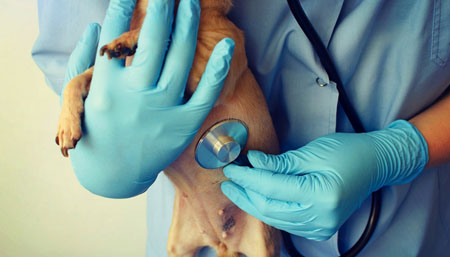Veterinary care is one of the largest expenses that dog owners need to budget for. Many of us don’t put a lot of thought into this expense because it doesn’t come around very often. We’re more focused on dog food, chew toys, treats and other products that we need to buy on a regular basis.
According to the American Pet Products Association, Americans spent over $15 billion in vet expenses in 2015. Most of these expenses were preventable by getting less expensive preventative care. Instead of looking at our short term budgets, we need to start looking at the long term. What can we do now that may save us money on vet care in the future?
There are many diseases and conditions that can be prevented by proper nutrition, good health and preventative treatments. In some areas of dog care, it doesn’t pay to be frugal. What may seem like a bargain today could cost more money in the long run. Add that into the pain and suffering experienced by your dog and yourself, and it really isn’t worth it.

Why Dog Parents Need to Care About Prevention?
There are at least 12 illness that can be prevented by getting your dog all his vaccinations at all the right times. I have personal experience with this. We took a dog from some friends who promised he was vaccinated, but we did not get proof. A couple of months later, our dog was sick with Parvo.
After my vet got the vaccination record from his previous vet, we saw he missed his last Parvo booster. Our dog almost died. It took 5 weeks of severe pain and sickness and about $500 in vet care (plus money from lost time at work), but he lived, barely.
Vaccinations cost $100 – $200 in the first year, and $20 – $50 for following years. Compare that to your dog’s life, or $500 or more for an illness.
It seems that vaccines are a hot button issue for some pet owners right now, but take the time to do the proper research and speak with your veterinarian before jumping on the bandwagon. There are pros and cons to both sides of the argument, you just need to make sure you’re doing what is best for your Fido.
Spay and Neuter
Many towns partner with vets to provide low cost spaying and neutering. Spaying and neutering prevents millions of unwanted pets every year. The ASPCA says that over 2 million unwanted pets are put down every year. Imagine the private and government costs this creates.
On a personal level, spaying and neutering your pet will cost $50 – $150. A dog abortion costs $75 – $200 dollars. A dog’s pregnancy costs include:
- vet care for mother and pups
- food and supplements for expecting mother
- formula for puppies if they can’t nurse
- additional emergency costs if anything goes wrong
- lost work time
All of this can add up to $200 – $500! Then you have 1-10 more dogs that need vaccinations, worming, food, and vet care. Not to mention advertising expenses if you hope to sell the puppies and the bill for all the appropriate health screenings that the puppies will need before they go to their new homes.
Dog Food
Chronic illnesses, like epilepsy and pancreatitis, can be prevented by feeding balanced dog food. Dog’s need 25-35% protein, 10-40% healthy fats, and 5-15% carbs in a serving of dog food. If you choose a food with a variety of meats, vegetables and grains, you also make sure your pooch gets all the vitamins and minerals he needs.
Besides saving your dog from the pain and confusion of illness, you also save money. A good dog food may cost $30 a month more than a cheaper food with poor nutrition, but it saves you $20 to $500 a month in possible vet office visits and medications.
Exercise
Everyone hears about the benefits of a fitness routine for people, but what about dogs? It turns out that all the benefits that people get from regular exercise, dogs get as well. There are even mental and emotional benefits for a dog that exercises.
Depending on size, breed and age, your dog needs about 15-30 minutes of rigorous activity a day along with 1-2 hours of regular activity. Get creative – maybe a 10-minute walk twice a day, and then some fetch in the evening.
There are many outdoor play toys you can get for your dog, even indoor play toys. For something that you can do for free in a back yard with a stick, it saves $20 – $500 a month in vet bills and medications for chronic illness, not to mention the increase in good physical and mental health in your dog.
Parasites
Dogs can be affected by many different parasites. Round worms, tape worms, fleas, mosquitoes and ear mites are just a few that could plague your furry friend. Some parasites can even be transmitted from the dog to their human owners.
Some dogs are allergic to fleas which leads to painful, itchy skin rashes, infection and hair loss. Mosquitoes transmit deadly heart worm infections. Intestinal parasites can cause anemia, diarrhea, and even death.
A person can purchase all in one treatments from their vet or local pet store for $20-$100 a month.
This saves misery for the dog and their owner. It also keeps the owner safe from getting parasites from their furry friend. Parasite prevention could save $50 to $500 a month in vet and doctor visits and treatments.
As you can see, veterinary bills and medication bills can add up pretty quick if your dog gets sick, especially if he ends up with a chronic illness.
It may seem like a lot of money for preventative treatments, but it saves a lot more money in the long run. That is why it is important to make a budget before you bring a puppy home and make sure that you can easily afford everything your new fur baby will need.
It is also a good idea to put aside a little money each month for unexpected pet expenses. Even if you just surrender your dog to a shelter if you end up not being able to afford pet care, you still pay. Approximately $1 billion is spent by the US government every year on shelters and the associated costs. That is of course, funded by tax payers – you and me. By spending a little to prevent canine illness, you are saving a lot in the long run.
Article reposted from:
http://topdogtips.com/prevention-cure-for-dogs/
By Amy Downs

Recent Comments